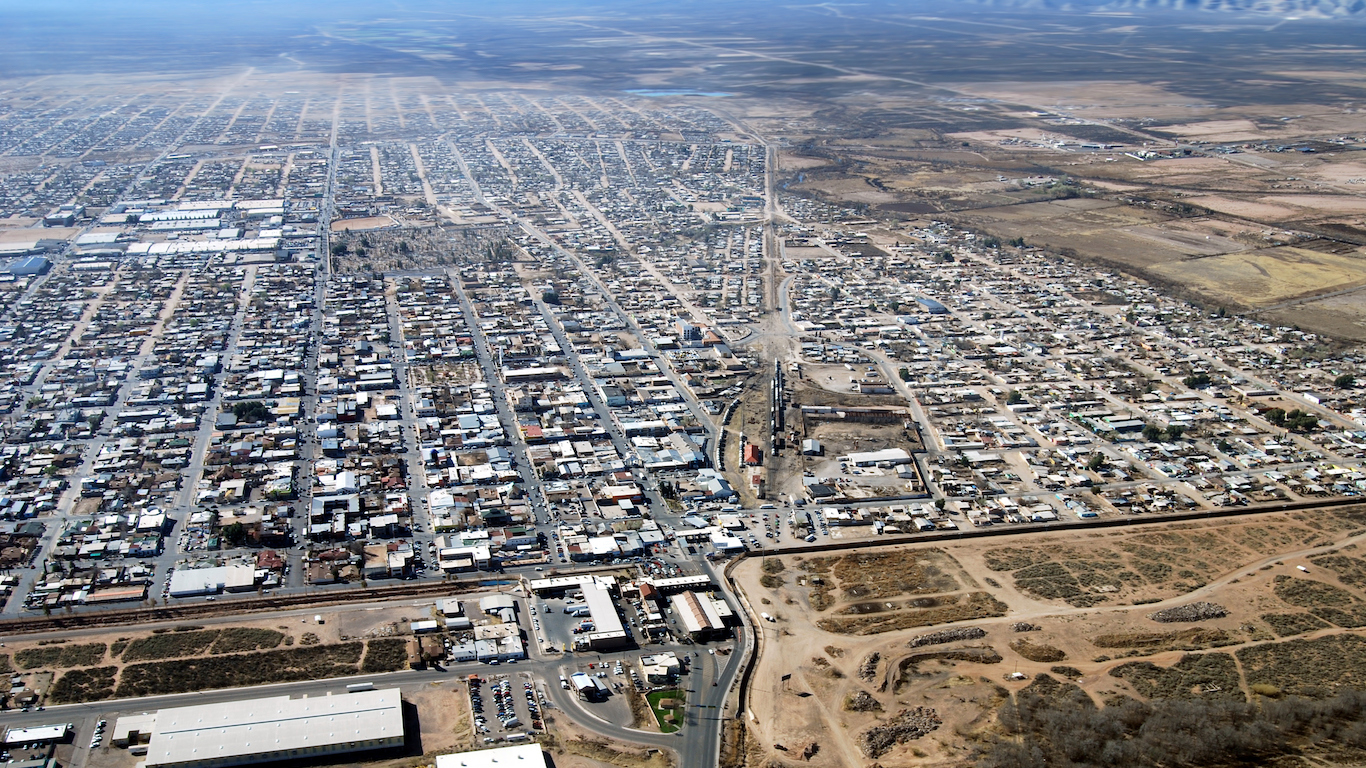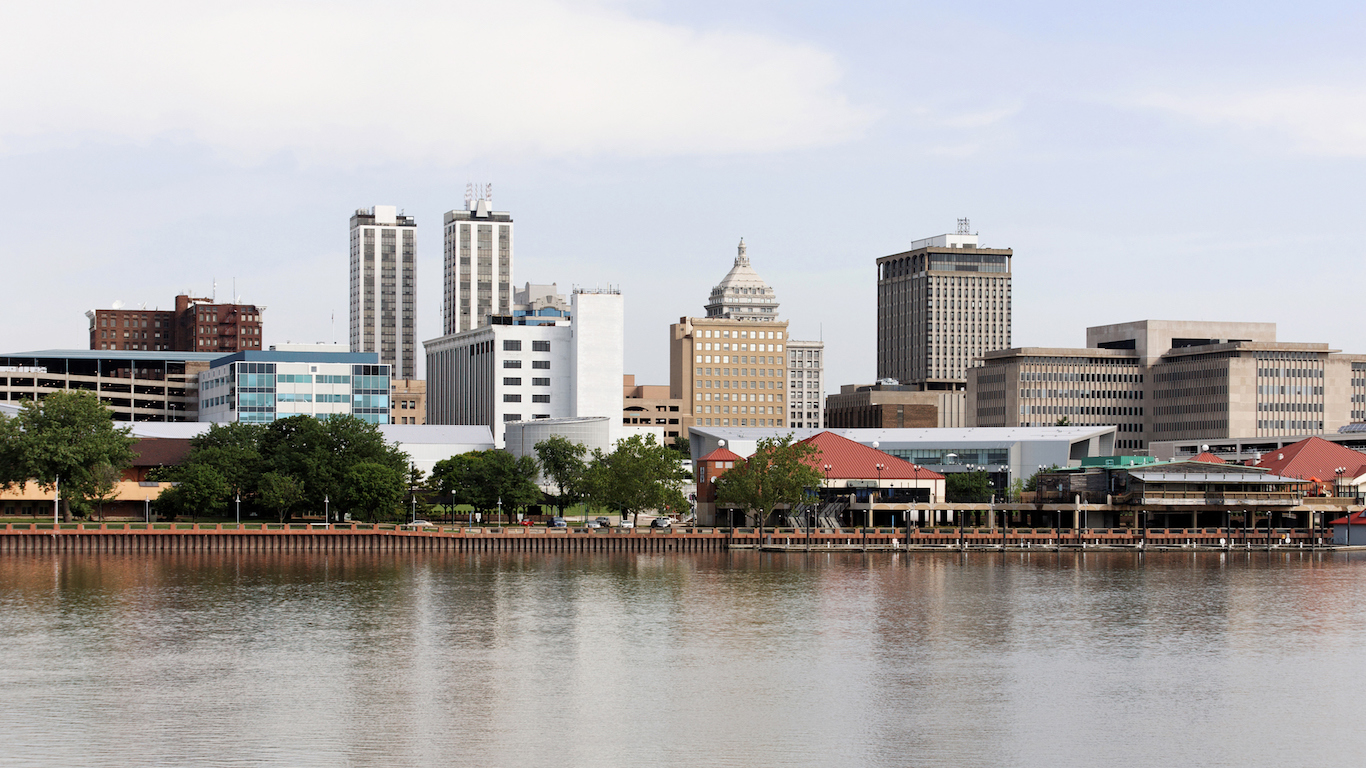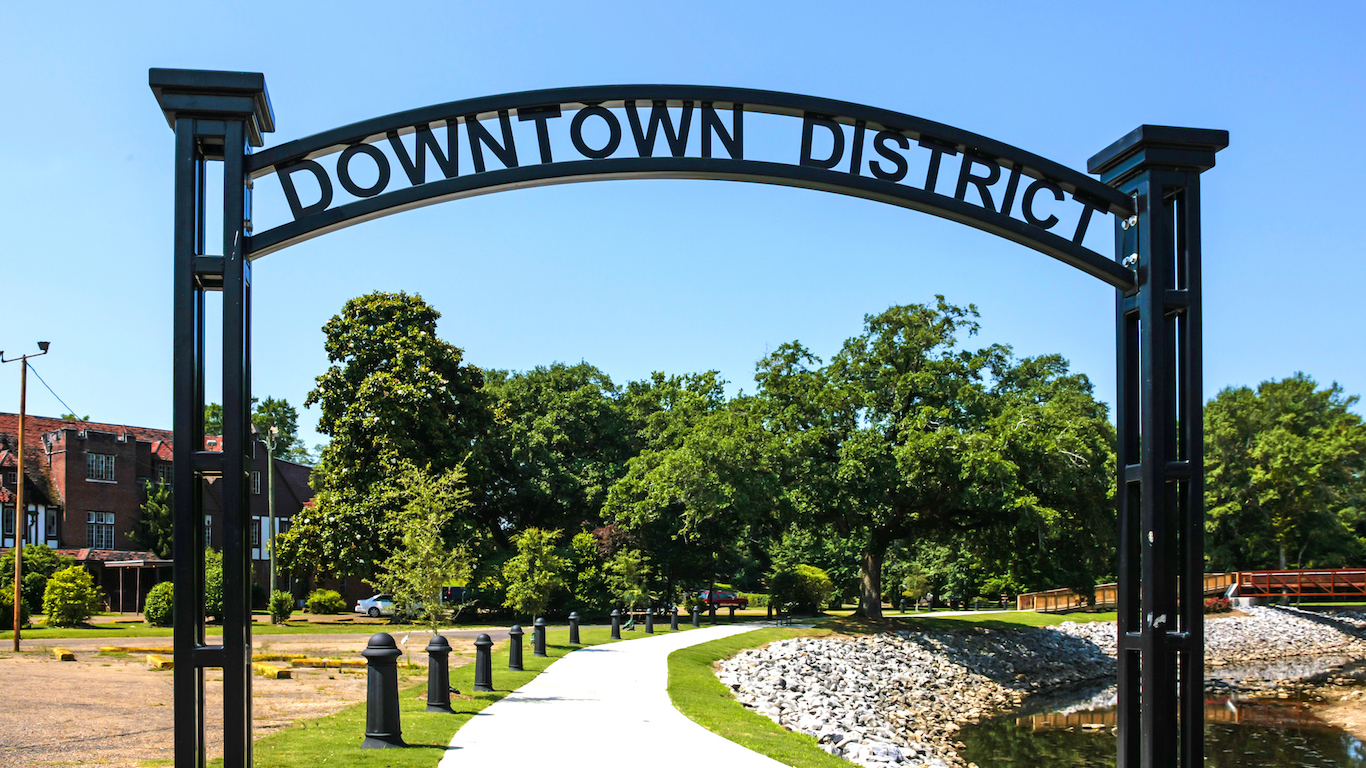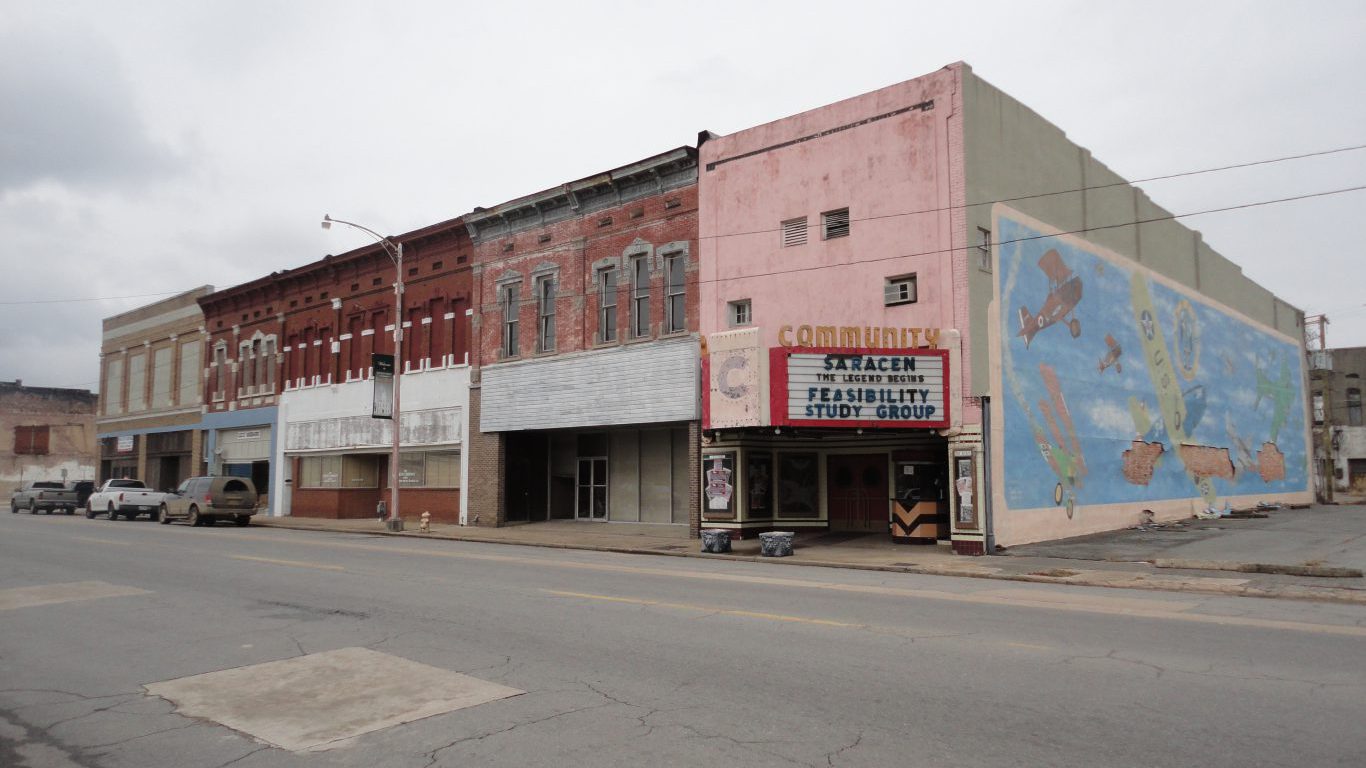Special Report
25 Cities Where You Don't Want to Get Sick

Published:
Last Updated:

Medical errors and suboptimal hospital conditions are a leading cause of death in the United States, resulting in hundreds of thousands of fatalities each year. Of course, some hospitals are worse than others, and the quality of care in a hospital depends largely on social and economic conditions where the facility is located.
A 2003 mandate requires the Centers for Medicare and Medicaid (CMS) to report several measures related to quality of care of hospitals across the United States in order to help Americans make more informed health decisions.
To determine the cities with the worst hospital care, 24/7 Wall St. created an index using data from the CMS and other sources. The index measures over a dozen indicators in three categories to assess the quality of hospital care in U.S. metro areas. The categories are mortality rate of patients within 30 days of admission, readmission rate within 30 days of discharge, and preventable hospitalizations.
To help ensure adverse outcomes are attributable to the hospitals rather than to factors related to the population the hospital serves, estimates of unplanned readmission and mortality are counted for patients only within 30 days of discharge.
Still, these indicators of hospital care quality can be very limited in scope. Variables such as patient frailty, the incidence and progression of chronic illnesses, and other factors may unfairly penalize some hospitals, especially those serving low-income populations. In fact, the median household income in all but one of the 25 cities with the worst-rated hospitals is lower than the national median of $57,617.
Click here to see the cities where you don’t want to get sick.
Click here to see our detailed findings.
Click here to see our methodology.

25. Sierra Vista-Douglas, AZ
> 30 day readmission rate: 16.4% (highest 10%)
> 30 day mortality rate: 13.3%
> Preventable hospitalizations: 48.6 per 1,000 patients
> No. of physicians: 46.7 per 100,000 (lowest 10%)
> Median household income: $45,508 (lowest 25%)
The Sierra Vista-Douglas metro area health system reports poor quality hospital care. The rates of readmission and mortality after 30 days, as well as the preventable hospitalization rate, are above the average across the nation’s hospitals. The 30-day mortality rate for stroke patients is especially poor, as nearly 1 in every 5 stroke patients (18%) will die within 30 days after being admitted to an area hospital, the 11th highest rate of all metro areas and significantly higher than the national 30-day mortality rate of 1 in every 7 stroke patients (14.6%). There are only 47 primary care physicians working in the Sierra Vista area per 100,000 residents, one of the lowest such proportions. Nationwide, there are 76 primary care physicians per 100,000 people.
Like nearly every city on this list, Sierra Vista-Douglas metro area hospitals serve a relatively disadvantaged population, at least in terms of income. The typical household earns $45,508 annually, well below the national median of $57,617.
[in-text-ad]

24. Florence-Muscle Shoals, AL
> 30 day readmission rate: 15.7% (highest 25%)
> 30 day mortality rate: 13.6%
> Preventable hospitalizations: 67.1 per 1,000 patients (highest 10%)
> No. of physicians: 56.5 per 100,000 (lowest 25%)
> Median household income: $45,287 (lowest 25%)
Avoidable hospitalizations are costly, disruptive, and can be disorienting for some, if not most, patients. More time spent at the hospital also means a higher likelihood of hospital-acquired infections. These unnecessary inpatient admissions tend to reflect inefficiencies in a health system, from issues of poor communication to low-quality or lack of outpatient services to staff failing to observe best practices. Across Florence-Muscle Shoals hospitals, there are approximately 67 preventable hospitalizations for every 1,000 patients, compared to the average preventable hospitalization rate nationwide of 50 per 1,000 patients.
Readmission within 30 days for most area patients were in line with the national average rates, except for pneumonia patients. Nearly 18% of pneumonia patients return to the hospital within 30 days of admission, one of the higher percentages of all metro areas.

23. Visalia-Porterville, CA
> 30 day readmission rate: 15.5%
> 30 day mortality rate: 14.5% (highest 10%)
> Preventable hospitalizations: 50.3 per 1,000 patients
> No. of physicians: 44.1 per 100,000 (lowest 10%)
> Median household income: $45,881 (lowest 25%)
Unlike other metro areas with relatively low-rated hospitals, mortality rates among Visalia-Porterville patients admitted for heart attacks and coronary artery bypass surgery are better than nationwide average rates — at 13.3% and 2.1%, respectively. For stroke and pneumonia patients, on the other hand, the likelihood of dying after hospitalization is considerably greater than it is in most metro areas.
Socioeconomic conditions likely contribute to the area’s poor hospital ratings. At 25.2%, the Visalia area’s poverty rate is sixth highest of all U.S. metro areas. Individuals living in poverty are at greater risk of certain health conditions. The number of doctors serving the metro area is also well below the national average. For every 100,000 residents, there are only 44 primary care physicians, versus 76 doctors per 100,000 people nationwide.

22. Altoona, PA
> 30 day readmission rate: 15.2%
> 30 day mortality rate: 14.9% (highest 10%)
> Preventable hospitalizations: 53.8 per 1,000 patients
> No. of physicians: 82.8 per 100,000
> Median household income: $43,443 (lowest 25%)
Altoona is the only metro area in Pennsylvania on this list, which makes the area’s hospitals the worst in the state and among the worst in the country. Of those admitted to area hospitals, approximately 15% die within 30 days, the 10th highest 30-day mortality rate of all U.S. metros. The area’s high mortality rate is largely driven by an especially high pneumonia mortality rate. Nearly 1 in 5 patients (19.3%) admitted for pneumonia in Altoona die within 30 days, the 13th highest rate of all U.S. metro areas. By contrast, fewer than 1 in 6 pneumonia patients (15.9%) die within 30 days of hospital admission nationwide.
Most metro areas on this list are home to relatively under-staffed hospitals serving relatively low-income communities. Altoona is one of the few with a lower poverty rate than the national rate, at 12.9%, and an above average ratio of primary care physicians per capita, at 83 for every 100,000 residents.
[in-text-ad-2]

21. Merced, CA
> 30 day readmission rate: 16.4% (highest 10%)
> 30 day mortality rate: 13.6%
> Preventable hospitalizations: 45.0 per 1,000 patients
> No. of physicians: 46.6 per 100,000 (lowest 10%)
> Median household income: $47,739
Recent research by the Association of American Medical Colleges and other organizations has revealed a growing doctor shortage in the United States. The ratio of primary care physicians per population is in some regions considerably lower than 76 per 100,000 people nationwide, particularly in metro areas with low-rated hospitals. Merced is one such case, with fewer than 50 doctors per 100,000 area residents. The area also reports above average readmission and mortality rates, although unlike the vast majority of metros with low-rated hospitals, Merced’s preventable hospitalization rate of 45 per 1,000 patients is lower than the national rate of 50 avoidable hospitalizations per 1,000 patients.
Approximately 20% of Merced residents live in poverty, one of the highest rates in the nation, but not unusually high for metro areas on this list. Individuals with low incomes are seemingly more likely to live in areas with relatively low-rated hospitals. Financial hardship of any kind also tends to increase the risk of certain health conditions.

20. Fort Smith, AR-OK
> 30 day readmission rate: 15.8% (highest 25%)
> 30 day mortality rate: 13.4%
> Preventable hospitalizations: 69.6 per 1,000 patients (highest 10%)
> No. of physicians: 74.6 per 100,000
> Median household income: $40,970 (lowest 10%)
Access to hospital care, as indicated by health insurance coverage rates, actually tends to be relatively good across the 25 cities with the worst-rated hospitals. But not in the Fort Smith metro area, where 12.4% of residents do not have health insurance, one of the highest uninsured rates in the nation. Area residents are not especially wealthy. The typical household earns $40,970 annually, and the poverty rate of 18.2% is among the higher poverty rates of all U.S. metros. Unstable financial situations can exacerbate health conditions and increase the risk of future diagnoses. Among other adverse health outcomes, the obesity rate in Fort Smith of 36.2% is 10th highest in the nation.
[in-text-ad]

19. Vineland-Bridgeton, NJ
> 30 day readmission rate: 16.5% (highest 10%)
> 30 day mortality rate: 13.0%
> Preventable hospitalizations: 63.8 per 1,000 patients (highest 25%)
> No. of physicians: 48.1 per 100,000 (lowest 25%)
> Median household income: $49,110
The likelihood of dying during the 30 days after being admitted to a hospital in the Vineland-Bridgeton metro area is only slightly higher than the national average 30-day mortality rate of 12.7%. However, the likelihood of being readmitted during this window, which all things equal should not occur after receiving optimal hospital care, is in the highest 10% of all metro areas.
Recent research by the Association of American Medical Colleges and other organizations has revealed a growing doctor shortage in the United States. The ratio of primary care physicians per population is in some regions considerably lower than it is nationwide, particularly in metro areas with low-rated hospitals. The Vineland-Bridgeton area is one such case. There are 48 doctors per 100,000 area residents, versus the average of 76 doctors per 100,000 people nationwide.

18. Morristown, TN
> 30 day readmission rate: 15.4%
> 30 day mortality rate: 14.0% (highest 25%)
> Preventable hospitalizations: 69.3 per 1,000 patients (highest 10%)
> No. of physicians: 49.7 per 100,000 (lowest 25%)
> Median household income: $44,348 (lowest 25%)
Avoidable hospitalizations and readmissions happen more often when mistakes are made. And mistakes are made more often at hospitals operating under resource, staffing, and other constraints. The proportion of doctors to area residents can therefore help explain the area’s poor hospital ratings. In the case of Morristown, there are fewer than 50 primary care physicians for every 100,000 people, a considerably lower ratio than the average of 76 doctors per 100,000 people nationwide. The low concentration of doctors is likely contributing to the high unnecessary hospitalization rate in the area. With 70 hospitalizations out of every 1,000 considered unnecessary, the area is among the worst 10% in the metric.
As is the case in nearly all of the metro areas with the worst-rated hospitals, the Morristown median household income of $44,348 a year is well below the national income level.

17. Sioux City, IA-NE-SD
> 30 day readmission rate: 15.3%
> 30 day mortality rate: 15.1% (highest 10%)
> Preventable hospitalizations: 47.2 per 1,000 patients
> No. of physicians: 54.0 per 100,000 (lowest 25%)
> Median household income: $56,687
High-income individuals tend to be better able to carry out doctor’s orders, be it exercise, food, or medicine. They are also more often served by higher-rated, better funded hospitals. Sioux City is somewhat of an exception, with the typical household earning $56,687 annually, in line with the national income level of $57,617. Yet, according to one gauge of hospital quality, 15.1% of patients die within 30 days of being admitted to Sioux City area hospitals — one of the highest such percentages of all metro areas.
As is common in metro areas with poorly-rated hospitals, there are only 54 primary care physicians per 100,000 area residents, well below the average nationwide. However, not all medical professionals are not in short supply in Morristown. For every 100,000 people in Sioux City, there are 144 dentists and 390 mental health providers, considerably higher proportions than the national ones of 66 dentists and 200 mental health providers per 100,000 people.
[in-text-ad-2]

16. Fresno, CA
> 30 day readmission rate: 16.2% (highest 10%)
> 30 day mortality rate: 14.1% (highest 25%)
> Preventable hospitalizations: 42.9 per 1,000 patients
> No. of physicians: 66.0 per 100,000
> Median household income: $48,715
The prevalence of low-income areas on this list suggests that CMS hospital quality assessments may be unfairly penalizing hospitals serving poor communities. Because many low-income patients may struggle to carry out a doctor’s orders — purchasing often expensive medications, for example — unplanned readmissions, deaths, and preventable hospitalizations may, in some cases, not be avoidable with hospital care alone. These scenarios may arise more frequently in the Fresno metro area than elsewhere, as more than 25% of area residents live in poverty. The incidence of preventable hospitalization, at 43 per 1,000 patients, is below the national average, but the 30-day readmission rate of 16.2% of patients is among the higher such figures nationwide. On the other hand, while low-income populations tend to report higher rates of certain adverse health outcomes, Fresno’s obesity rate of 26.3% is one of the lowest in the country.

15. Homosassa Springs, FL
> 30 day readmission rate: 15.1%
> 30 day mortality rate: 15.4% (highest 10%)
> Preventable hospitalizations: 50.9 per 1,000 patients
> No. of physicians: 56.0 per 100,000 (lowest 25%)
> Median household income: $39,206 (lowest 10%)
Homosassa Springs hospitals actually do better than most metro areas health systems in avoiding readmissions within 30 days. The readmission rate, at 15.1%, is just under the national average of 15.3%. The relatively low overall likelihood of returning to the hospital after the initial visit is due to the particularly low readmission rates among patients with certain conditions, like pneumonia. The readmission rate for Homosassa Springs pneumonia patients is 15.1%, one of the lowest in the country. Unfortunately, this may not be due to quality hospital care. The metro area also reports the nation’s highest 30-day mortality rate for pneumonia patients — 21.8% die shortly after leaving the hospital.
Access to hospital care, as indicated by health insurance coverage rates, actually tends to be relatively good across the 25 cities with the worst-rated hospitals, but not in the Homosassa metro area — where 1 in every 10 area residents do not have health insurance, one of the highest uninsured rates in the nation. Area residents are not especially wealthy. The typical household earns less than $40,000 annually, among the lowest of U.S. metro areas.
[in-text-ad]

14. Little Rock-North Little Rock-Conway, AR
> 30 day readmission rate: 16.3% (highest 10%)
> 30 day mortality rate: 13.8% (highest 25%)
> Preventable hospitalizations: 50.6 per 1,000 patients
> No. of physicians: 76.0 per 100,000
> Median household income: $51,501
With a population of 734,622 and 12 hospitals (with available data), the Little Rock metro area is one of the larger urban regions and health care systems on this list.
On average, 16.3% of patients return to the hospital 30 days after being admitted, one of the highest 30-day readmission rates of all U.S. metro areas. Nationwide, readmission is highest among heart failure patients, and in Little Rock area’s hospitals this is especially the case. Approximately 24% of patients admitted for heart failure are readmitted within 30 days. Given the poor heart health of the area’s population this readmission rate may suggest, it is likely no coincidence that the 30-day mortality rate for stroke, at 16.5% of patients, is one of the highest such rates.

13. Peoria, IL
> 30 day readmission rate: 15.8% (highest 25%)
> 30 day mortality rate: 14.5% (highest 10%)
> Preventable hospitalizations: 50.3 per 1,000 patients
> No. of physicians: 83.1 per 100,000
> Median household income: $57,090
Of health conditions tracked by the Centers for Medicare and Medicaid Services, pneumonia is attributed the most deaths of patients in the 30 days after being admitted to hospital. Nationwide, the 30-day mortality rate for pneumonia patients is 15.9%. In Peoria, nearly 19% of pneumonia patients die within 30 days of being admitted to area hospitals, one of the highest rates compared to other U.S. metro areas. Readmission for pneumonia is also relatively common, with hospital return within 30 days occurring for more than 18% of patients.
Peoria area hospitals do relatively well with respect to heart attack patient readmissions. Unlike nearly every other city with the worst-rated hospitals, 15.1% of heart attack patients return to the hospital in the 30 days after being admitted — below the national average rate of 16.3%.

12. Utica-Rome, NY
> 30 day readmission rate: 16.3% (highest 10%)
> 30 day mortality rate: 13.9% (highest 25%)
> Preventable hospitalizations: 58.4 per 1,000 patients (highest 25%)
> No. of physicians: 66.0 per 100,000
> Median household income: $52,534
Residents of most of the 25 cities with the worst hospitals actually have relatively high health insurance coverage rates, and Utica-Rome is no different. Just 3.4% of area residents do not have health insurance, an especially low rate and less than half the national uninsured rate of 8.6%. With a poverty rate of 16.4%, above the national rate of 14.0%, it is likely many individuals — even with health insurance — struggle to follow doctor’s orders, be it exercise, food, or medicine. High-income individuals tend to be better able to carry out such orders, just as they are more likely to live in communities served by high-rated hospitals.
Comparing Utica-Rome to other U.S. metros, it seems the area may have a shortage of medical professionals. For every 100,000 residents, there are 66 primary care physicians, 30 dentists, and 61 mental health practitioners, each considerably lower than the respective national proportions.
[in-text-ad-2]

11. Tuscaloosa, AL
> 30 day readmission rate: 16.3% (highest 10%)
> 30 day mortality rate: 13.8% (highest 25%)
> Preventable hospitalizations: 70.2 per 1,000 patients (highest 10%)
> No. of physicians: 65.0 per 100,000
> Median household income: $46,086 (lowest 25%)
With high quality outpatient treatment and disease management, many hospitalizations can be avoided. A high rate of preventable hospitalizations is one indication that a community’s health needs are not being met. In Tuscaloosa, just shy of the 10 cities with the worst hospitals, there are more than 70 avoidable hospitalizations for every 1,000 patients, considerably higher than the national average rate of 50 per 1,000 patients.
Tuscaloosa residents are not wealthy. The metro area’s median household income of $46,086 a year is in the bottom quarter of all metro areas, and the poverty rate of 18.8% is well above the national poverty rate of 14.0%. Precarious financial situations can exacerbate health conditions and increase the risk of future diagnoses, and this is partially reflected in high readmission rates. Among other adverse health outcomes, the obesity rate in Tuscaloosa of 34.9% is one of the highest in the nation.

10. Hot Springs, AR
> 30 day readmission rate: 15.9% (highest 25%)
> 30 day mortality rate: 14.4% (highest 10%)
> Preventable hospitalizations: 63.7 per 1,000 patients (highest 25%)
> No. of physicians: 75.1 per 100,000
> Median household income: $42,826 (lowest 10%)
Preventable infections, which can occur after surgery, are one major cause of unplanned readmissions to hospitals. According to the CMS ratings of St. Vincent hospital, one of the three major hospitals in the area, bloodstream and surgical site infections occur at much lower rates than they do nationwide. However, the hospital is considerably worse than national averages at avoiding urinary tract, MRSA, and C.difficile infections. The readmission rate across Hot Springs hospitals of 15.9% is among the higher rates among U.S. metro areas.
The mortality rate in area care facilities is also higher than it is across the country. Of patients admitted to area hospitals, 14.4% die within 30 days of admission, one of the highest percentages compared to all U.S. metros.
[in-text-ad]

9. Lakeland-Winter Haven, FL
> 30 day readmission rate: 17.0% (highest 10%)
> 30 day mortality rate: 13.2%
> Preventable hospitalizations: 74.0 per 1,000 patients (highest 10%)
> No. of physicians: 49.5 per 100,000 (lowest 25%)
> Median household income: $46,355 (lowest 25%)
As the strong correlation between poverty and hospital quality would suggest, unplanned readmission, mortality, and unnecessary hospitalizations may be harder to avoid in low-income communities. For example, low-income patients who cannot afford the medication their doctors prescribe often end up returning to the hospital. This scenario is likely relatively common and is reflected in the high readmission rate in Lakeland-Winter Haven, where 12.8% of residents do not have health insurance, and 16.4% of people live in poverty, each among the highest respective rates of all U.S. metro areas. The typical household earns $46,355 annually, also among the lowest in the country.
The Lakeland area has remarkably few health professionals relative to the area’s population. For every 100,000 residents, there are fewer than 50 primary care physicians, less than 5 dentists, and 11 mental health practitioners, among the lower concentrations of U.S. metro areas.

8. Hanford-Corcoran, CA
> 30 day readmission rate: 16.2% (highest 10%)
> 30 day mortality rate: 14.8% (highest 10%)
> Preventable hospitalizations: 49.2 per 1,000 patients
> No. of physicians: 39.7 per 100,000 (lowest 10%)
> Median household income: $53,234
During the 30 days after admission to a hospital, hospital patients in the United States are more likely to die from pneumonia than any other health condition. The deadliness of the disease is especially severe in the Hanford metro area, where more than 1 in every 5 pneumonia patients die within 30 days of being admitted to an area hospital, the third highest proportion of all metro areas. Similarly, the 30-day mortality rate for patients admitted for COPD, an umbrella term for chronic lung conditions, is especially high at nearly 1 in every 10 patients admitted for the disease.
No city on this list has fewer doctors per capita than Hanford-Corcoran. There are fewer than 40 primary care physicians per 100,000 area residents, versus the national ratio of 76 doctors per 100,000 people.

7. Wheeling, WV-OH
> 30 day readmission rate: 16.2% (highest 10%)
> 30 day mortality rate: 13.8% (highest 25%)
> Preventable hospitalizations: 83.1 per 1,000 patients (highest 10%)
> No. of physicians: 77.0 per 100,000
> Median household income: $44,131 (lowest 25%)
Relatively frequent preventable hospitalizations in the Wheeling metro area the primary reason for the city’s poor hospital ratings. Over 83 of every 1,000 patients admitted to area hospitals reviewed might have been prevented with better outpatient and disease management services. By contrast, there are approximately 50 avoidable hospitalizations per 1,000 patients nationwide.
Not as shockingly high as the area’s preventable hospitalizations, Wheeling’s 30-day mortality rate of 13.4% of patients is just slightly above the average across the country of 12.7%. But deaths tied to certain procedures performed at area hospitals are troubling. For instance, 7% of individuals undergoing coronary artery bypass grafting (CABG) in Wheeling die within 30 days, more than double the comparable national 30-day mortality rate.
[in-text-ad-2]

6. Clarksville, TN-KY
> 30 day readmission rate: 16.0% (highest 25%)
> 30 day mortality rate: 14.6% (highest 10%)
> Preventable hospitalizations: 62.3 per 1,000 patients (highest 25%)
> No. of physicians: 41.3 per 100,000 (lowest 10%)
> Median household income: $51,373
Some 14.6% of patients die within 30 days of being admitted to a hospital in Clarksville — among the highest rates in the country. Mortality rates are particularly high for heart attack and pneumonia patients. More than 15% of heart attack patients, and nearly 20% of pneumonia patients, die in the 30 days after admission.
The poor outcomes may be due to inefficient allocation of hospital resources. Preventable hospitalizations are often an indication of inefficiency, and Clarksville has one of the highest preventable hospitalization rates in the country. For every 1,000 hospital patients, 62 could have been treated in an outpatient facility.

5. Kingston, NY
> 30 day readmission rate: 17.6% (highest 10%)
> 30 day mortality rate: 13.3%
> Preventable hospitalizations: 58.1 per 1,000 patients (highest 25%)
> No. of physicians: 69.4 per 100,000
> Median household income: $62,790 (highest 25%)
Compared with the 24 other metro areas on this list, Kingston residents are exceptionally wealthy. The typical household earns $62,790 annually, well above the national median. By contrast, the poverty rate of 14.1% is in line with the national poverty rate. Also unlike most cities with poor-rated hospitals, Kingston residents do not report especially poor health outcomes. The area’s obesity rate of 27.2%, for example, is below the national rate.
Still, hospitals report high rates of readmission, mortality, and preventable hospitalization. In addition, Kingston hospitals, and the area’s health system more generally, also have far fewer medical professionals than most areas. For every 100,000 area residents, there are 69 primary care physicians, versus the national proportion of 76 doctors per 100,000 people. The number of area dentists, at just 34 per 100,000, is approximately half the nationwide ratio of 66 per 100,000 people.
[in-text-ad]

4. Hattiesburg, MS
> 30 day readmission rate: 17.9% (highest 10%)
> 30 day mortality rate: 13.2%
> Preventable hospitalizations: 63.3 per 1,000 patients (highest 25%)
> No. of physicians: 86.7 per 100,000 (highest 25%)
> Median household income: $46,765 (lowest 25%)
As the strong correlation between poverty and hospital quality metrics would suggest, unplanned readmission, mortality, and unnecessary hospitalizations may be harder to avoid in low-income communities. For example, low-income patients who cannot afford the medication their doctors prescribe often end up returning to the hospital. This scenario is likely relatively common in Hattiesburg, where 12.8% of residents do not have health insurance, and 19.8% of people live in poverty, each among the highest respective rates of all U.S. metro areas.
Hattiesburg area hospitals report the highest 30-day readmission rate in the nation, at 17.9%. More than 1 in every 4 patients admitted for heart failure return to the hospital inside 30 days, also the highest such rate of all metro areas.

3. Jonesboro, AR
> 30 day readmission rate: 17.2% (highest 10%)
> 30 day mortality rate: 13.7% (highest 25%)
> Preventable hospitalizations: 68.2 per 1,000 patients (highest 10%)
> No. of physicians: 91.1 per 100,000 (highest 25%)
> Median household income: $41,717 (lowest 10%)
Hospitals in many of the metro areas on this list often struggle with greater demands on their resources. For one, their patients can be at greater risk of health conditions due to low income. Also, lower funding can lead to doctor shortages and obsolete equipment. Jonesboro is somewhat of an exception. For every 100,000 residents, there are 91 primary care physicians, 68 dentists, and 473 mental health providers — each proportion considerably higher than the respective national one.
While there does not appear to be a shortage of medical professionals in the area, the hospital system still appears relatively strained. Poor readmission, mortality, and preventable hospitalization rates are likely due in part to low incomes and poor health outcomes reported across the Jonesboro metro area population. The typical household earns $41,717 annually, one of the lowest median incomes in the nation. The area’s obesity rate of 36.8% is also seventh highest of all U.S. metros.

2. Rocky Mount, NC
> 30 day readmission rate: 17.3% (highest 10%)
> 30 day mortality rate: 14.6% (highest 10%)
> Preventable hospitalizations: 59.2 per 1,000 patients (highest 25%)
> No. of physicians: 50.0 per 100,000 (lowest 25%)
> Median household income: $38,972 (lowest 10%)
Like nearly every metro area with the worst-rated health care systems, Rocky Mountain area hospitals serve relatively low-income communities. The typical household in the area earns $38,972 a year, one of the lowest median household incomes in the nation. Financial struggles often exacerbate existing health conditions and can increase the risk of future diagnoses, increasing the burden on medical systems. Individuals with low income can find it difficult to carry out doctor’s orders, be it exercise, food, or costly prescription drugs. Failing to follow through on recommended care can push up the likelihood of returning to the hospital. The 30-day readmission rate in Rocky Mount, at 17.3% of patients, is the fourth highest out of all metro areas. The 30-day mortality rate, at 14.6%, is also among the highest of all metro areas.
[in-text-ad-2]

1. Pine Bluff, AR
> 30 day readmission rate: 16.9% (highest 10%)
> 30 day mortality rate: 15.2% (highest 10%)
> Preventable hospitalizations: 60.4 per 1,000 patients (highest 25%)
> No. of physicians: 61.9 per 100,000
> Median household income: $37,076 (lowest 10%)
With among the nation’s highest readmission, mortality, and preventable hospitalization rates, hospitals in the Pine Bluff metro area are struggling more than any other metropolitan area health care system. Widespread poverty, poor health, and relatively few medical professionals serving the area help explain the ranking. Approximately 40% of adults in Pine Bluff are obese, the highest obesity rate of all metro areas. Over time, health issues such as obesity can drive up doctor visits, increase the risk of a range of conditions, and ultimately raise the burden on hospitals.
As is generally the case in cities with poorly-rated hospitals, likely because of the close correlation between health outcomes and financial status, Pine Bluff’s poverty rate of 21.8% is one of the highest poverty rates in the country. For every 100,000 people in the area, there are 62 primary physicians, versus the national proportion of 76 per 100,000 U.S. residents.
Detailed Findings
The CMS measures are risk adjusted, which allows for more accurate comparisons between areas with sicker populations and those with healthier populations. The assumption is that patients who receive high quality care during their hospitalizations will likely have better outcomes, at least within the 30 days following a hospital discharge.
The effects of extreme poverty and low incomes still tip the scale, however. A Kaiser Health Foundation study found that hospitals with the highest share of low-income Medicare patients are three times as likely as others to have high readmission rates for heart failure.
Nationwide, 15.3% of hospital patients are readmitted to the hospital within 30 days. Readmission rates in 23 of the 25 cities on this list exceeds that percentage.
Deaths that occur in the 30 days following initial hospital admission is another key metric of the quality of hospital care. Nationwide, 12.7% of patients admitted die within a month. In the 25
cities with the worst hospitals the 30 day mortality rate exceeds this national figure, to as high as 15.4% in the Homosassa Springs, Florida metro area.
According to a 2014 study published in the Journal of General Internal Medicine, in half of U.S. hospitals, 1 in 7 patients admitted for acute myocardial infarction (also known as a heart attack) die within 30 days of admission. Mortality rates among heart attack and other heart-related condition patients are generally high in all 25 cities.
Recent research by the Association of American Medical Colleges and other organizations has pointed to a growing doctor shortage in the United States. The ratio of primary care physicians per population is in some regions considerably lower than the 76 doctors per 100,000 people nationwide, particularly in metro areas with low-rated hospitals. Of the 25 cities with the worst-rated hospitals, 19 have fewer primary care physicians per capita than the national ratio.
Methodology
To determine the cities with the worst hospital care, 24/7 Wall St. created an index of data from the Centers for Medicare and Medicaid Services (CMS) and other sources. The CMS produces statistics on numerous health measures for more than 4,000 Medicare-certified hospitals in the country. We grouped hospitals by metropolitan areas and aggregated the hospital data to the MSA level.
The index measures three sets of indicators: 30-day mortality rates, 30-day readmission rates, and preventable hospitalizations. Mortality and readmission rates each make up 42.1% of the index, and the rate of preventable hospitalizations makes up the remaining 15.8%.
Mortality rates
We calculated a weighted average of 30-day mortality rates for heart attacks, chronic obstructive pulmonary disease (COPD), coronary artery bypass grafting (CABG), heart failure, pneumonia, and stroke patients to find the average percentage of people who died within 30 days of being admitted to a hospital. The mortality measures are adjusted for differences in risk variables such as age, comorbidities, and patient frailty. CMS estimates the data for 30-day mortality by each condition per hospital from Medicare patients.
Readmission rates
The readmission measures are estimates of unplanned readmission to an acute care hospital in the 30 days after discharge from a hospitalization for Medicare beneficiaries 65 or older. Patients may have an unplanned readmission for any reason.
Preventable hospitalization
Lastly, we used the share of hospitalizations for conditions that could have been treated at outpatient or ambulatory care facilities — often referred to as the preventable hospitalization rate. This measure counts hospitalizations for conditions such as asthma, dehydration, or hypertension per 1,000 patients. This data came from the 2017 County Health Rankings report, an annual analysis produced by the Robert Wood Johnson Foundation.
Want retirement to come a few years earlier than you’d planned? Or are you ready to retire now, but want an extra set of eyes on your finances?
Now you can speak with up to 3 financial experts in your area for FREE. By simply clicking here you can begin to match with financial professionals who can help you build your plan to retire early. And the best part? The first conversation with them is free.
Click here to match with up to 3 financial pros who would be excited to help you make financial decisions.
Thank you for reading! Have some feedback for us?
Contact the 24/7 Wall St. editorial team.